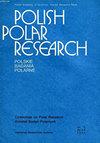Molecular composition of humic substances isolated from permafrost peat soils of the eastern European Arctic
IF 0.8
4区 地球科学
Q4 ECOLOGY
引用次数: 7
Abstract
Abstract: Humification plays an important role in stabilization of organic matter in soils of the cryolithic zone. In this context, the degree of organic matter stabilization has been assessed, using instrumental methods, for permafrost peat soils of the eastern European Arctic, based on selected plots from within the Komi Republic (Russian Federation). Humic substances (HSs) isolated from the mire permafrost peats of the forest-tundra subzone of the European Arctic have been characterized in terms of molecular composition. This was accomplished using elemental and amino acid fragments (AAFs) composition. Solid-state 13C nuclear magnetic resonance (13C NMR) spectroscopy was utilized to identify the structure of HSs. Changes in the molar x(H) : x(C) ratio, ratio of aromatic to paraffin fragments and ratio of hydroxy AAFs to heterocyclic AAFs along the peat profiles have been revealed. They are due to the activation of cryogenic processes in the upper part of the seasonally thawing layer, the natural selection of condensed humic molecules, the botanical composition and degree of degradation of peat, which reflect the climatic features of the area in the Holocene. Humic acids and fulvic acids of the peat soils showed the prevalence of compounds with a low degree of condensation and a low portion of aromatic fragments. The aromaticity degree showed the trend to increase within the depth. Changes of quantitative and qualitative parameters of specific organic compounds occur at the permafrost boundary of peatlands, which can serve as an indicator of recent climate changes in environments from the high latitudes. The presented data can be useful in the evaluation of soil organic matter stabilization degree in the active layer and below the permafrost table.从东欧北极永久冻土区泥炭土中分离的腐殖质物质的分子组成
摘要腐殖化作用在冻石器带土壤有机质稳定中起着重要作用。在这方面,利用仪器方法,根据科米共和国(俄罗斯联邦)境内选定的地块,评估了东欧北极永久冻土区泥炭土的有机质稳定程度。从欧洲北极森林-苔原亚带的沼泽冻土泥炭中分离出的腐殖质(HSs)在分子组成方面具有特征。这是完成使用元素和氨基酸片段(AAFs)组成。利用固态13C核磁共振(13C NMR)光谱对hs的结构进行了鉴定。揭示了泥炭分子x(H): x(C)比、芳烃与石蜡碎片之比以及羟基与杂环AAFs之比的变化。季节解冻层上部低温过程的激活、凝聚腐殖质分子的自然选择、泥炭的植物组成和降解程度反映了该地区全新世的气候特征。泥炭土腐殖酸和黄腐酸中存在低凝结度和低芳香碎片含量的化合物。芳香度在深度内呈增加趋势。泥炭地冻土带边界特定有机化合物的定量和定性参数发生变化,可作为高纬度地区近期气候变化的指标。所得数据可用于评价活动层及多年冻土层以下土壤有机质的稳定程度。
本文章由计算机程序翻译,如有差异,请以英文原文为准。
求助全文
约1分钟内获得全文
求助全文
来源期刊

Polish Polar Research
ECOLOGY-GEOSCIENCES, MULTIDISCIPLINARY
CiteScore
2.00
自引率
7.70%
发文量
0
审稿时长
>12 weeks
期刊介绍:
The quarterly Polish Polar Research edited by the Committee on Polar Research of the Polish Academy of Sciences is an international journal publishing original research articles presenting the results of studies carried out in polar regions.
All papers are peer-reviewed and published in English.
The Editorial Advisory Board includes renowned scientist from Poland and from abroad.
 求助内容:
求助内容: 应助结果提醒方式:
应助结果提醒方式:


